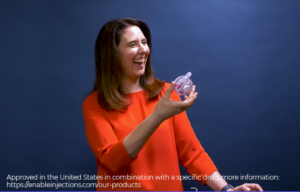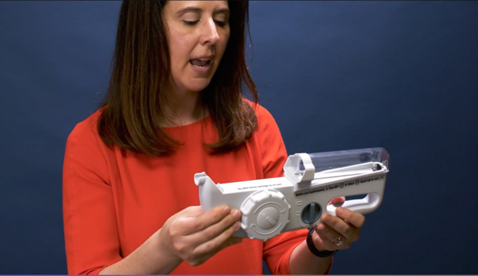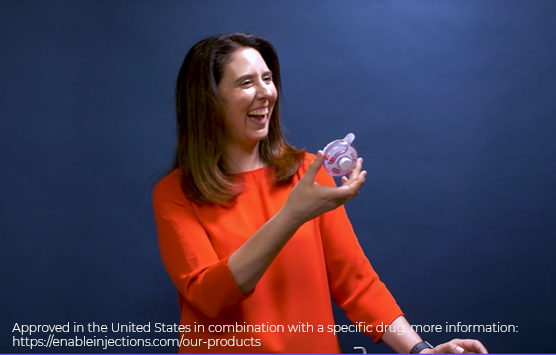
The Call for Freedom – A Patient’s Perspective on Today’s Drug Delivery Systems
More than 133 million people in the United States live with a chronic disease2, which is defined as a “condition that lasts one year or more and requires ongoing medical attention or limits activities of daily living or both.”1 Pharmaceutical companies create medications to address health concerns, but treatment options can lack convenience and ease-of-use for patients. Many of these life-changing treatments must be delivered parenterally, or through intravenous (IV) or subcutaneous routes of administration, to bypass the digestive system, and be effective for the patient. But this type of delivery has challenges, often including poor ease-of-use, larger needles, visible needles, and more. While patients often regain their health from these therapeutics, current delivery options take additional time and resources. From long infusions in an IV chair in the clinic to cumbersome processes for patients to navigate on their own at home, these challenges often create burdens for patients.
Meet Rebecca

Rebecca is a wife, a mom to a teenage daughter, a healthcare professional, and is one of the more than 133 million people in the US living with a chronic disease. She was diagnosed with Common Variable Immunodeficiency Disorder (CVID) 15 years ago. CVID is “a primary immune deficiency disease characterized by low levels of protective antibodies and an increased risk of infections.”3 Patients of CVID are known to face additional health challenges such as bronchitis, other autoimmune disorders, digestive disorders, and solid tumor cancers.4
For Rebecca, the road to treatment was long and difficult. A bout of pneumonia in her early twenties started the journey and continued into her thirties when she was diagnosed with fungal sinusitis. Doctors suspected there may be an underlying cause of Rebecca’s illnesses, but it was not for another 10 years until Rebecca was able to receive her CVID diagnosis. Even with the diagnosis, Rebecca faced years of doctors’ visits and failed rounds of antibiotics until she was finally able receive insurance approval for her subcutaneous IgG infusions.
Managing Chronic Illness Today

While Rebecca’s subcutaneous IgG infusions have made a largely positive impact on her health, the management of these treatments takes a large mental, emotional, physical, and economic burden on Rebecca and her family. After just one demonstration with a nurse practitioner, Rebecca began infusing weekly with a handheld pump.
To complete her infusions, Rebecca starts by loading the medication into her pump with a handheld syringe. She then takes two butterfly needles, about an inch long apiece, and proceeds to “pinch an inch” of her abdominal tissue to be able to insert the needles. The fear and anxiety from inserting a needle into yourself is something Rebecca says she had to learn to work through. The fear of needles, Trypanophobia, affects up to 25% of US adults, some of which may avoid infusion treatments altogether due to symptoms such as panic attacks, nausea, palpitations, and fainting.5
After the needles are inserted, Rebecca must tape these needles down to ensure they are secure. Because of the additional tubing that connects the needles to the pump, Rebecca must lie immobile for at least an hour while her administration completes to avoid the tubing catching on normal household objects, a painful experience Rebecca does not want to repeat. Because the current pump forces medication into her tissue at a constant rate, it can still lead to an abundance of injection site discomfort.
From start to finish, Rebecca’s infusions take up to 2 hours; however, the time commitment required for her infusions also include scheduling her infusions and managing the supplies. Rebecca’s infusion regimen forces her to plan her life – travel, work, mom duties – around her infusions.
Rebecca’s current infusion system is unwieldy, expensive, and robs her of precious time she could be spending living her life. When asked what it would mean to her to have options, she said, “It would take a great strain off my mind to be able to have other options, which today I don’t.”
enFuse® Enables Freedom

“When I look at the enFuse, I think of freedom.”-Rebecca
Rebecca is passionate about improving the patient experience and was intrigued when she heard about the innovative enFuse delivery system. After seeing the enFuse and completing a demonstration, Rebecca had this to say, “This [enFuse] is smaller. It’s easier to handle. So many less supplies to have to worry about. And I don’t have to see the needle, which is the best part. It seems very simple to use. It’s very intuitive… and it was so fast. That’s what I love about it. You can be infusing in under 2 minutes, go to the grocery store, go to the track meet. Nobody has to even know.”
The current standard of care for at home SC infusions comes with many challenges that take a toll on the patient. The enFuse from Enable Injections has the potential to alleviate many of these challenges, improving the patient experience, and giving people like Rebecca their lives back. To hear Rebecca’s full story, watch here: https://youtu.be/Vr0HBexg-Ac
- “About Chronic Diseases.” Centers for Disease Control and Prevention, Centers for Disease Control and Prevention, 21 July 2022, www.cdc.gov/chronicdisease/about/index.htm.
- Raghupathi, Wullianallur, and Viju Raghupathi. “An Empirical Study of Chronic Diseases in the United States: A Visual Analytics Approach.” International Journal of Environmental Research and Public Health, U.S. National Library of Medicine, 1 Mar. 2018, www.ncbi.nlm.nih.gov/pmc/articles/PMC5876976/.
- “Common Variable Immunodeficiency (CVID).” National Institute of Allergy and Infectious Diseases, U.S. Department of Health and Human Services, www.niaid.nih.gov/diseases-conditions/common-variable-immunodeficiency-cvid#:~:text=Common%20variable%20immunodeficiency%20(CVID)%20is,an%20increased%20risk%20of%20infections. Accessed 13 Oct. 2023.
- Odnoletkova, Irina, et al. “The Burden of Common Variable Immunodeficiency Disorders: A Retrospective Analysis of the European Society for Immunodeficiency (ESID) Registry Data – Orphanet Journal of Rare Diseases.” BioMed Central, BioMed Central, 12 Nov. 2018, ojrd.biomedcentral.com/articles/10.1186/s13023-018-0941-0.
- Robert H. Shmerling, MD. “Terrified of Needles? That Can Affect Your Health.” Harvard Health, 27 Apr. 2021, www.health.harvard.edu/blog/terrified-of-needles-that-can-affect-your-health-2021042722470.
